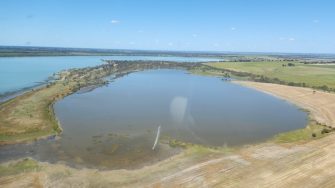
Date: Wednesday October 18th 2023
Project: Eastern Australian Waterbird Survey
Observers: John Porter (NSW DPE), Paul Wainwright (SA DEW)
Trainee: Scott Henshall (Vic GMA)
Pilot: Thomas Clark
Departing Narracoorte on another perfect day for waterbird survey, we tracked north to reach survey band two and then continued east. We started the band counting a series of small dams and natural temporary wetlands. One of these dams is called Pink Lake, near the town of Dimboola. This highly saline lake is, as the name would suggest, bright pink! But not from red Dunaliella algae as was previously assumed. A recent study reported by Australian Geographic describes how the pink colouration is primarily due to a bacterium Salinibacter ruber (although some Dunaliella is still present). As usual though it has almost no birds.
Pink Lake, near Dimboola.
The first big wetland on our list of jobs was Lake Buloke. It is a shallow, temporary wetland that can extend up to 4,800 ha when full and it can also support high numbers of waterbirds. Today the lake was only about 50% percent full and apparently drying back but there were thousands of waterbirds; mainly Grey Teal and also hundreds of Chestnut Teal, Hardhead, Pink-eared Duck, Wood Duck and Black Duck.
The Corop wetlands / Cooper Lakes are our next large wetlands and we found them full of water and waterbirds! The next hour or so very busy as we swoop around to identify and count the waterbirds on each of the 20 or so wetlands in this system.
Surveying Cooper Lake
Waranga basin is a large (5,000 ha) freshwater storage reservoir in the Goulburn River basin. It was constructed primarily for water storage and irrigation and has deep turbid water that generally is not high quality habitat for waterbirds. True to form we found low numbers of waterbirds consisting of manily terns, cormorants and Pelicans.
We finished the day counting over Lake Mokoan, a decommissioned water storage that was also about 50% full. Lake Mokoan's water looked black and heavily coloured with organic material, there were however moderate numbers of waterbirds consisting mainly of Wood Duck, Grey Teal and Black Duck. Though Black Swans, coot and egrets were also common.
Week Three survey team left to right - Tom Clark, Paul Wainwright and John Porter

